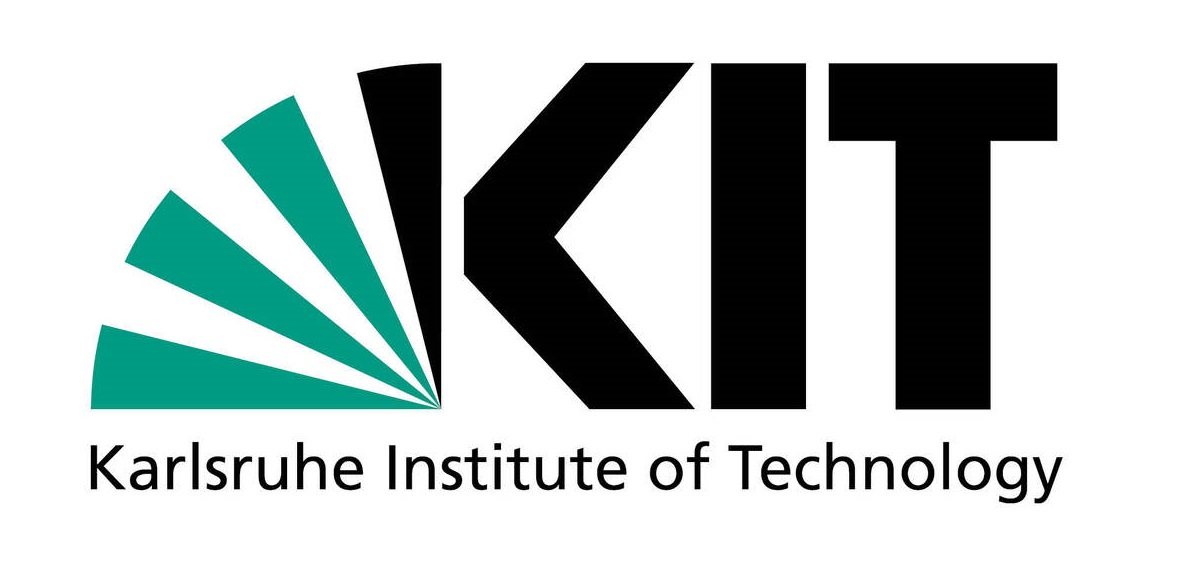Summary
The overall goal of this project is the numerical and experimental evaluation of the cyclic performance of components that suffer from forming-induced damage. It takes the final role in the process route by assessing the loading capability of the formed and pre-damaged components. The first funding period covered low cycle fatigue and the second funding period extended it to higher numbers of load cycles. An anisotropic gradient-extended model was developed for the prediction of damage through a close cooperation between experimental characterization and continuum mechanics. It was validated by a damage-sensitive testing methodology for axial-torsional loading and successfully predicted the performance of forward-extruded components. The high cycle regime (~ up to 105 cycles) and low temperatures (as low as -40°C) will be the first key extension towards advanced phenomena in the third funding period. The low temperatures promote quasi-brittle behavior for a focused model validation and cover test standards to consistently extend the evaluation scenarios in the TRR. The damage mechanisms relevant to quasi-brittle behavior will be classified by sensitive material characterization and simulated by efficient physics-based extrapolation schemes over various cycle ranges. Furthermore, the activation of quasi-brittle damage at low temperatures and lower numbers of cycles reduces the computational and experimental costs compared to the high numbers of cycles at room temperature. A second focus will be put on anisotropic damage evolution. It is particularly relevant for cyclic load collectives with varying or mixed load paths, but standard influencing factors like stress triaxiality and Lode angle become insufficient in the anisotropic case. Exploiting the full potential of damage-controlled component design in the TRR therefore requires the determination of further sensitive factors under axial-torsional load paths. The load paths will be mapped, numerically and experimentally, via non-proportional or load asynchronous stress states under combined tension, compression and torsion. 16MnCrS5 case hardening steel will serve as a prototype material and the methodological transferability will then be verified by aluminum alloys. Uncertainties arising during operational service conditions will complete the framework by two types of variabilities, variability of forming and variability of service loads. While the former can induce heterogeneous damage distributions, the latter is even beyond the controllability of the process chain. The model will therefore capture advanced complexity in space and time, e.g. imperfections or shocks, by developing activation criteria that adapt to the evolution of internal plasticity and damage variables. The combined simulations and experiments will eventually isolate high-risk settings and provide guidelines for damage mitigation. This completes the development of a damage model for service conditions of formed components and the evaluation of the entire process chain.
Project progress to date
Report and current state of research
State of knowledge and initial question when the last proposal was submitted
While the 1st funding period (FP) started with a focus on ductile damage models and heuristic approaches in the available literature, the second period could draw on the further evolution of gradient-based models [Mar16, *Lan20] and damage criteria [Lem05]. Another subsidiary research area for the 2nd FP was the development of numerically efficient cycle and time-extrapolation schemes [Sal20, Juk23, Fri18]. The available knowledge yet did not cover the required complexity of damage-controlled forming processes in terms of both physical mechanisms and numerical extent. External studies also provided information on the load path dependence [Sha19], but have not explored the initial scenario of materials with forming-induced damage. The focus on isotropic materials or idealized loads in literature lacked the extension to anisotropic damage evolution interacting with other mechanisms, thus requiring the development of novel methods. The 2nd FP accordingly followed the main question of how parts with forming-induced damage perform under fatigue loading with higher numbers of cycles. This underlines the connecting position of SP C01: It assesses the forming-induced damage as input and predicts the performance under service loads until failure. Two types of damage have been explicitly distinguished for this purpose, so-called ductile damage and quasi-brittle damage. Albeit many other damage classifications (fatigue, cyclic damage, etc.), this distinction unifies the multitude of underlying processes by two prototype classes. Following a convention in continuum mechanics, ductile damage is associated with macroscopic plastic deformations (e.g., low numbers of cycles or large strains) and quasi-brittle damage without macroscopic plasticity (e.g., high numbers of cycles or low temperatures). Damage initiation criteria and growth conditions were accordingly linked to accumulated plastic or elastic energy contributions, respectively. In contrast to forming-induced damage, both types need to be considered for operational conditions. The 2nd FP was consequently guided by two extensions: Higher numbers of cycles with a transition from ductile to quasi-brittle damage and geometric features of (semi-)finished products. The model had to:
- account for the transition towards quasi-brittle damage,
- couple it with the existing ductile damage model and
- incorporate an efficient time-homogenization scheme for higher numbers of cycles.
With regard to the experimental characterization of loading capability, new methods have been applied to evaluate forming-induced damage and to separate it from other influencing factors. This implies:
- temperature-dependent cyclic deformation behavior of 16MnCrS5 components,
- interaction of axial-torsional cyclic loading and forming-induced damage and
- distribution of voids in the volume and their influence on the cyclic deformation behavior.
To embed the results of SP C01 into the overall TRR, the numerical-experimental cooperation finally aimed at
- the calibration of case hardening steel and
- the evaluation scenarios for fatigue loading capability.
The results are presented below in line with the 2nd FP and its (O)bjectives-(M)echanics/(E)xperimental.
Results and newly developed methods
Modeling of quasi-brittle damage and coupling with ductile damage (former objectives O-M1&2)
The foundation for the extension towards quasi-brittle damage has been laid by developing a new gradient-enhanced model [*Lan20]. Its feasibility was tested by a rigorous comparison of three regularization concepts: the fracture energy concept, viscous regularization and a micromorphic gradient regularization [*Lan22]. This could be achieved by a unified variational framework based on the underlying rate potential I ̇=ψ ̇+D ̇, which consists of the Helmholtz free energy and the dissipation [Ort99]. Their generalized prototype forms read
![]()
where d is the damage variable, f(d) is the degradation function, ψ0 is the Helmholtz free energy of the undamaged material, cd is an energetic coupling constant between damage and micromorphic field φ, ld is the length-scale parameter, cE is an energetic scaling constant and η is the viscosity. Ill-posed local models (η=0, cd=0) are known to suffer from severe mesh dependency. The fracture energy concept enforces the fracture energy Gf by the product of volume-specific energy and the characteristic element diameter. This allows to adapt the model parameters to the mesh size, but the underlying equation system remains ill-posed. The viscous regularization (η>0, cd=0) renders the model well-posed and controllable on the material point level, but most notably caused a fluctuating width of the damage zone and an unphysical unloading behavior due to inhomogeneous strain rates, see Fig. 1.
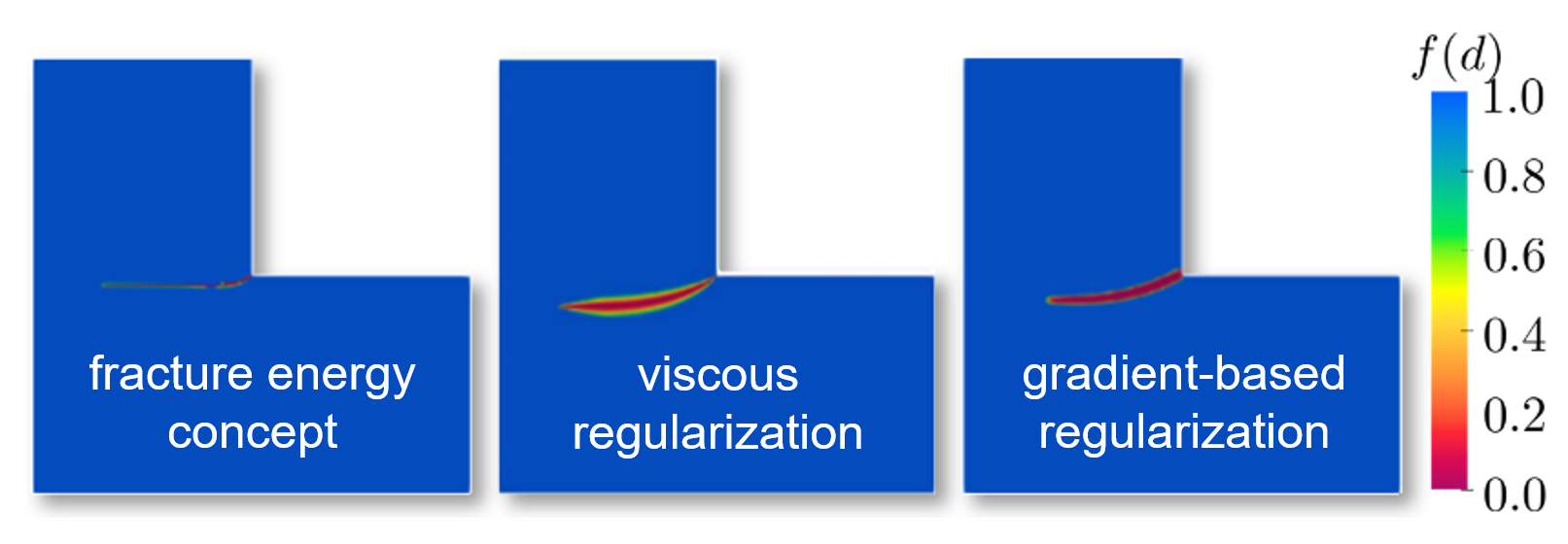 |
| Fig. 1: Degradation function f(d) in a quasi-brittle L-shaped specimen regularized (from left to right) by the fracture energy concept, viscous regularization and gradient-based regularization [*Lan22]. |
The micromorphic gradient-based regularization (η=0, cd>0) yields a well-posed problem and showed the least numerical side-effects on the physical solution. Despite the higher computational effort, its generality makes it the preferable choice for a framework that evaluates complex damage evolution with different rates and variable geometries or loads. The extension of the anisotropic damage model to the transition zone of low cycle fatigue (LCF) and high cycle fatigue (HCF) requires the coupling of ductile (•d) and quasi-brittle (•b) damage mechanisms. The effective damage tensor d hence depends on ductile damage dd and (quasi-)brittle damage db, respectively. As a first prototype, an additive split of the Helmholtz free energy has already been implemented in the micromorphic, gradient-regularized form
![]()
Furthermore, the quasi-brittle damage model has been adapted to cyclic behavior (Fig. 2) by the concept of an endurance surface [Ott08] and extended to anisotropic damage evolution. States outside of the endurance surface lead to the evolution of quasi-brittle damage. The elastic domain is independent of the endurance surface, so that the modeling of cyclic behavior becomes feasible – in contrast to standard rate-independent quasi-brittle damage models.
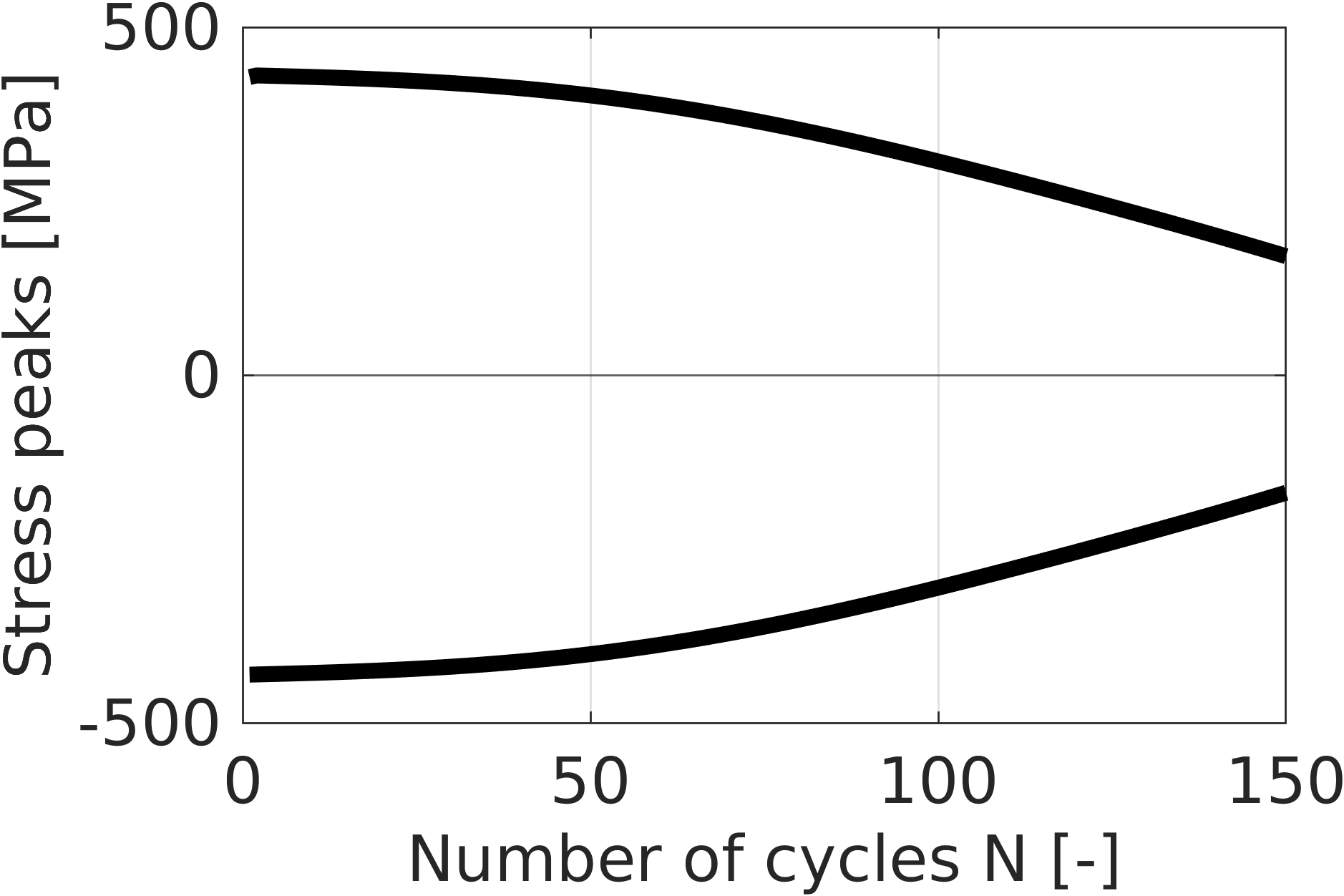 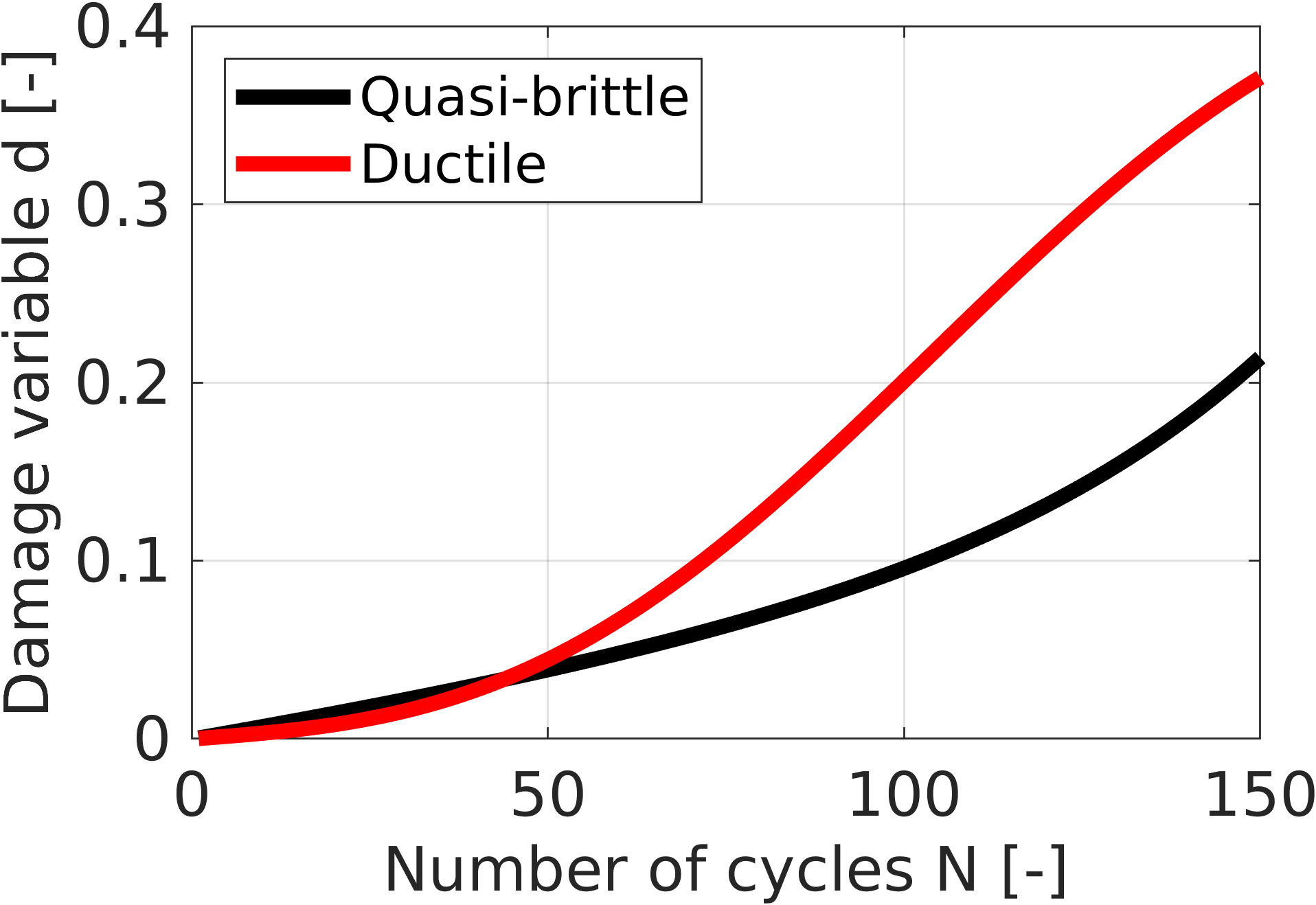 |
| Fig. 2: Modeling of stress peaks and damage under cyclic tension. Evolution of quasi-brittle damage is determined by an endurance surface [Ott08] and coupled to plasticity-driven ductile damage [*Lan20] for overall degradation. |
Another noteworthy, yet unexpected outcome was the dependence of gradient-regularized models on the curvature of the damage zone [*Lan23b]. This was demonstrated for micromorphic and phase-field formulations. Calibration of L-shape simulations allowed the study of freely evolving cracks for a prototype model of quasi-brittle damage. The study indicated that the zone of a freely evolving crack did not only depend on a sufficiently small mesh size h and the regularization length ld, which was state-of-the-art knowledge. Back-calculation of the fracture energy from the simulation showed that also the crack curvature κ had a non-negligible impact. This could be explained by a methodological side-effect that is not apparent in one-dimensional interpretations. Mathematically, a divergence term can be reformulated to highlight an interference with the crack’s curvature. The evolving damage zone of gradient-based methods hence depends on the triple {h, ld, κ} and not only on {h, ld}. Correction terms for κ were proposed for situations where curved damage fields become relevant, e.g., forming-induced nucleation or turning points of evolving damage fields [*Lan23b]. It also affected the response of the damaged structure, which underlines the significance for the life-time evaluation of components with forming-induced damage.
Cycle extrapolation and time homogenization (O-M3)
Engineering systems in various fields of application undergo cyclic loading, but high numbers of cycles naturally cause a steep increase in computational costs. An efficient handling of information for damage prediction is hence required. It was shown that a minimal sufficient set of input variables improves classic models and data-driven predictions of artificial neural networks [*Geu23], which suppresses noise, bias and overfitting. A numerically efficient scheme has moreover been developed to predict the damage evolution for load cases with higher numbers of cycles, see Fig. 3. A recursive cycle extrapolation strategy was employed after comparing various first and second-order extrapolation methods. It uses multiple, parallel simulation (child-)threads, each with a different extrapolation length. The coarser the stepping, the larger the expected savings and error. After a fixed run time, the thread with the largest extrapolation jump, yet within a specified error tolerance, is chosen as the next parent thread. This method uses parallel CPU resources for time saving. Its efficiency depends on the settings, which have been carefully tested by adjusting the stepping spectrum, the number of threads as well as the retrospective error norm and its variables. Damage-sensitive load paths on the material level (e.g., tension and shear) and on the component level (e.g., L-shape and notched bending plate) have been evaluated with respect to their loading capability.
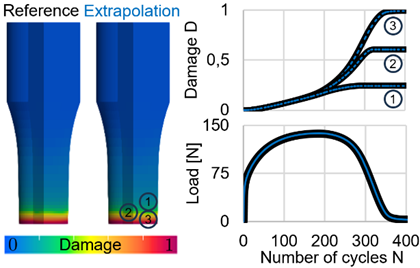 |
| Fig. 3: Damage of selected points and load evolution of a cyclic tensile test comparing a fully resolved simulation (black) vs. cycle extrapolation (blue). |
Evaluation of temperature-dependent fatigue loading capability under complex stresses (O-E1)
A test rig and test concept were developed to characterize damage accumulation as a function of the interaction between uni- and multiaxial load paths and test temperatures, with a focus on the ductile-brittle fracture transition for forward-rod extruded 16MnCrS5. By using axial-torsional strain measurement in combination with structure-sensitive measurement techniques such as resistometry and thermography, the thermomechanical damage accumulation during the fatigue test was detected. A reduction of the test temperature from 20°C to -30°C is in line with the FKM guideline and is applied for the mathematical strength verification of steel machine components [FKM21]. In addition, the influence of forming-induced damage due to forward extrusion, which is controlled by the process parameter of the shoulder opening angle 2α, was investigated with respect to the fatigue behavior in the LCF range [*Möh22]. The material response in form of load decrease (FTemperature;2α) for strain-controlled fatigue tests with a total strain amplitude εa,t = 1.0%, stress ratio R = -1, and angular amplitude θ = 10° is qualitatively comparable for both shoulder opening angles of 2α = 30° and 2α = 90°. Cyclic softening was observed, particularly in the first few cycles before a linear decrease of the load occurs (Fig. 4).
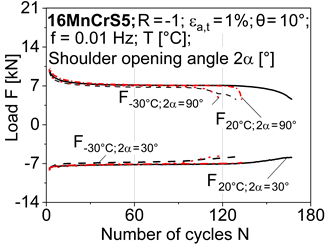 |
| Fig. 4: Forming-induced damage due to forward extrusion and temperature-dependent fatigue behavior [*Lin23]. |
Due to different forming-induced damage states, the fatigue loading capability of the specimen with a shoulder opening angle of 30° is higher by a factor of 1.26 at T = 20°C and by a factor of 1.11 at T = ‑30°C in comparison to the shoulder opening angle of 90°. Regarding the temperature effect, lowering the test temperature from T = 20°C to T = -30°C reduces the number of cycles to failure by 23% for a shoulder opening angle 30° and by 14% for a shoulder opening angle of 90°, which is explained by the more brittle behavior of the bcc crystal lattice of the ferritic-pearlitic structure at low temperatures. The effect of cyclic softening at T = -30°C is comparable to cyclic softening at room temperature with a significant drop load decrease during the first five cycles [*Lin23]. Furthermore, a decrease in yield stress in the compression region can be observed, which is due to known phenomena such as the Bauschinger effect. Initial investigations using X-ray diffraction (XRD) measurements have established a qualitative correlation between cyclic softening and dislocation structures. During cold forming, dislocations accumulate at barriers such as precipitates and grain boundaries and form dislocation clusters and entanglements, leading to an increase in dislocation density. As a result of cyclic loading, there was a decrease in dislocation density. These initial findings motivate a comprehensive model to cover ductile and quasi-brittle damage for a larger spectrum of temperatures and higher numbers of cycles.
Microstructural analyses of the distribution of voids (O-E2)
Scanning electron microscopy (SEM) techniques were used to evaluate and separate the stress and temperature-dependent fatigue damage mechanisms as a function of the forming-induced damage for forward-rod extruded 16MnCrS5. The use of intermittent fatigue tests with different stress collectives allowed the identification of fatigue loading-dependent damage mechanisms, such as crack growth. Fractographic investigations of the multiaxially loaded specimens revealed different fracture types on the fracture surfaces, which consists of both ductile fracture and typical fatigue fracture areas. The fracture surface of the axial‑torsional loaded specimen shows multiple radial incipient cracks which are characteristic for the applied load-path (Fig. 5a). These cracks propagate through the volume at approx. 45° in the direction of the maximum normal stress. The cracks were initiated mainly at voids near manganese sulfides (MnS). Analysis of the fracture surfaces of specimens manufactured with different shoulder opening angles under comparable mechanical loading confirmed the described influence of crack initiation near the MnS inclusions. The void distribution could by analyzed by preparing representative cubic volume elements using focused ion beam (FIB) preparation (Fig. 5b). The data has also been used for the development of a 3D-volume modelling approach by the use of AI-image segmentation [*Ott23]. This measurement method was compared and validated in conjunction with the TRR method developed by B04. In addition, IPF-mappings (Inverse Pole Figure) and KAM-mappings (Kernel Average Misorientation) were obtained by electron backscatter diffraction (EBSD) in SEM. The KAM-mappings show the local misorientation of grains, which relate to the local strain energy and geometrical necessary dislocation density changes due to fatigue loading.
 |
| Fig. 5.: a) Macroscopic fracture surface of a sample with a shoulder opening angle of 30° after axial-torsional fatigue loading and b) a 3D‑analysis of the microstructure using SE overview image, I) SE detail image, II) IPF-mapping and III) KAM-mapping. |
Model calibration and extension of additional mechanisms (O-ME1)
The combined numerical-experimental approach did not only allow for calibration of the model but also helped to identify characteristic experimental load conditions to support that task (within elastic, plastic and damaged regimes) [*Lan23a]. A major challenge lies in the complex forming-induced deformation state, which exhibits a plastic deformation history that makes the evaluation of formed components more demanding than for pristine materials. This was observed, for instance, in the form of a significant tension-compression asymmetry of the formed material, e.g., for the peak load and the yield limit (Fig. 6b). The model was furthermore adapted to the anisotropic plastic state by more general formulations of anisotropic distortional hardening.
Most importantly, the model was calibrated to different states of forming-induced damage. This was experimentally enabled by specimens of different shoulder opening angles during forward-rod extrusion (2α = 30° vs. 90° in Fig. 6a).The impact of forming-induced damage was observed and modeled via various characteristics of the subsequent fatigue tests. The two most prominent outcomes were the anisotropic superposition of hardening and softening and a 9% difference of sustained cycles between both damage states. The fluctuations among specimens were accounted for by rank-based tests and indicated the need for a more rigorous future assessment of uncertainties. These findings support the significance of the TRR’s endeavor for damage control. As a methodological result, an individual damage initiation criterion was derived on the basis of accumulated plastic strain for cyclic loading [*Lan23a]. It distinguishes low from highly damaged steel after forming, considering for complex load paths. In addition, axial-torsional fatigue tests were performed and the underlying damage mechanisms were validated by advanced metallographic and fractographic methods.
Evaluation scenarios of forming-induced damage and sensitive load paths (O-ME2 and O-E3)
A further key outcome of the collaboration between numerical modeling and materials engineering are damage-critical evaluation scenarios and sensitivity analyses. Systematic numerical and experimental investigations were performed to quantify the influence of initial forming-induced damage under non-proportional, asynchronous axial-torsional load paths with complex stress superpositions (Fig. 6a). Cyclic softening was demonstrated for all forming-induced damage states, yet with different slopes depending on the amount of forming-induced damage (Fig. 6b). In the case of axial-torsional fatigue loading, the fatigue behavior of the material furthermore depends on the phase shift, that describes the phase angle between the cyclic axial and torsional loading. The major contribution to damage among the tested load paths was due to axial loading. A phase shift of 90° between axial and torsional loading led to an increase of the initial load level by 37% (Fig. 6c). For a total strain amplitude of εa,t = 0,25% with an angular amplitude of θ = 10°, the number of load cycles was reduced by 20% compared to a phase shift of 90°. These findings demonstrate that damage influences various characteristics of the service life behavior such as cyclic softening. Even more so, this influence depends on the load path that must be carefully explored with evaluation scenarios reflecting the conditions of the problem at hand. From the modeling perspective, the anisotropic response of formed steel further motivated a rigorous comparison of isotropic and anisotropic damage models under various load paths, monotonic and cyclic ones. It was demonstrated that also stress-related influencing factors other than the well-established stress triaxiality and Lode angle parameter can substantially augment damage evolution. Fluctuating rotations around a simple tension state degraded the elastic moduli by several percent. This can be explained by a complex, anisotropic damage evolution that is particularly relevant for components, which develop damage during an initial forming process and subsequent, different service loading. This effect is amplified for complex geometries and load perturbations as they easily trigger heterogeneous stress and deformation states that are prone to fluctuating stresses.
 |
| Fig. 6: a) Visualization of experimental setup (specimen from the extruded component) and simulation for axial LCF tests; b) Load evolution vs. number of cycles (vertical red and blue lines denote the averaged onset of fatigue damage); c) Evolution of load and torsional moment vs. number of cycles for phase shift-dependent axial-torsional fatigue tests. |
Challenges and difficulties during the implementation of the work program
The calibration of the case hardening steel with forming-induced damage was expected to be complex compared to an undamaged material. It indeed showed a strongly anisotropic response in axial and shear directions under cyclic loading. Softening and hardening effects were particularly difficult to calibrate after the forming-induced damage already reduced the elastic moduli. This goal has been successfully met with appropriate yield functions and a novel damage initiation criterion [*Lan23a]. The latter involved a new threshold that explicitly accounts for the level of forming-induced damage in line with the project goal of assessing the influence of damage on product properties within the TRR. The variational framework for quasi-brittle damage [*Lan22] moreover allowed to compare and interpret multiple model extensions, i.e., regularization methods, cycle extrapolation schemes and micromorphic vs. phase-field formulations. The investigation of dual phase steel DP800 was put on hold for this systematic methodological assessment, as the anisotropic behavior of case hardening steel was prioritized. The latter was required to explain the novel experimental and numerical insights of damage evolution made by SP C01 with parts formed in the A‑area of the TRR. Initially planned low-temperature experiments with a thermal chamber were delayed due to severe supply restrictions of electronic components and specialized glass windows during the Covid-19 pandemic. A successful test series was eventually conducted, triggering the desired quasi-brittle behavior.
Cooperations with other projects within the Collaborative Research Centre
The developed model and the testing methodology for damage evolution under cyclic, multi-axial loading have been used in other subprojects within the Collaborative Research Centre. In particular, the possible influence of damage orientation was discussed in [Wan20]. For SP A02, fatigue loading capability was evaluated as a function of shoulder opening angle and degree of pre-deformation. The correlation between damage severity and fatigue loading capability was conjointly demonstrated in [*Lan23a]. The choice of complex loading conditions was moreover supported by load paths studied in SP S01 and A06. In cooperation with SP B01, resistometry-based measurement methods for the evaluation of forming-induced ductile damage were linked to the 3D-void distribution measurements developed in SP C01 [*Lin22]. In cooperation with the T01 transfer project, the Bauschinger effect and the development of damage along the manganese sulphides were demonstrated by means of in-situ tensile tests in the SEM. With regard to complex component geometries, both the experimental characterization and the simulative prediction of the fatigue loading capability could be successfully demonstrated on first complex demonstrators in cooperation with SP A02.
Comparison with works outside the Collaborative Research Centre
Modeling ductile and quasi-brittle damage has a long tradition and their coupling was for instance recently also studied in [Sel21, You21]. Efficient simulation strategies by cycle extrapolation are also found in view of the relevance of reliable lifetime predictions [Sal20, Juk23]. Their fruitful impulses were considered for the present approach, e.g., in the form of damage initiation criteria [Lem05, Gab19], but lack the TRR focus on forming-induced damage. Interactions with other mechanisms, complex damage states and anisotropy required the development of a novel framework. The framework of C01 stands out, for instance, by the implementation of novel damage initiation criteria adapted to forming-induced initial damage, error measures for simultaneous plastic and damage extrapolation as well as the careful correction of numerical interference with the physical behavior [*Lan23a/b].
Summary and derived research questions
The goal of a predictive damage model for service loads in the 2nd FP was achieved by extending the basis of the 1st FP to ductile and quasi-brittle damage with damage evolution criteria for non-pristine states in formed components. The interference of numerical regularization with damage growth was moreover revisited and thoroughly reduced. The experimental materials testing methods allowed the distinction of relevant fatigue damage states during the cyclic loading with the aim of calibration. Together, the impact of forming-induced damage was analyzed and simulated for various geometric and loading conditions. For instance, the combined numerical-experimental approach accounts for the loss of elastic moduli as well as anisotropic plastic and damage evolution under service loads. Damage initiation criteria have been developed depending on the pre-deformed state and the microstructural evolution during the operating loads. A first-time successful assessment of the lifetime of extruded components in LCF range was made based on experiments and simulations with other projects of the TRR and underlines the project’s leading role to evaluate the impact of forming-induced damage and thus guide its control. The first upcoming research question for the 3rd FP is that of:
- How to model damage evolution in the HCF range and low test temperatures for formed components?
Only a view on the entire spectrum of service loads from the LCF to the HCF range can cope with the task of reliable fatigue loading capability evaluation within the TRR. The lower temperature range allows to promote quasi-brittle damage for smaller number of cycles and to mimic low-temperature test cases. The second research question derives from the numerical and experimental observations of anisotropic damage evolution, which indicated influences beyond stress triaxiality and Lode angle parameter alone. The question arises:
- What are the influencing factors in multi-axial load paths for anisotropic damage evolution?
A generalization of the already identified sensitivities in terms of materials and model classes must explore the full range of damage-control capabilities in line with the TRR’s overall purpose. The third future research question asks for:
- How to efficiently cope with the advanced complexity and uncertainty of service life conditions by an adaptive numerical framework?
Spatial inhomogeneities like imperfections and temporal fluctuations like variable frequency or load orientation require a numerical adaption in time and space. Numerical efficiency will be achieved by linking the algorithms to the active physical mechanisms. It hence completes the development of three FPs towards a cutting-edge damage model that is able to consider and assess uncertainties unique to forming-induced damage and subsequent operational loads within the entire process chain.
Project- and subject-related list of publications
|
[FKM21] Analytical strength assessment of components: Made of steel, cast iron and aluminium materials FKM guideline. 7th ed. Frankfurt am Main: VDMA Verlag GmbH; 2021. [Fri18] Fritzen, F., Hassani, M., 2018. Space–time model order reduction for nonlinear viscoelastic systems subjected to long-term loading. Meccanica 53, 1333-1355. DOI: 10.1007/s11012-017-0734‑x. [*Geu24] Geuken, G.-L., Mosler, J., Kurzeja, P., Incorporating sufficient physical information into artificial neural networks: a guaranteed improvement via phyiscs-based Rao-Blackwellization. Computer Methods in Applied Mechanics and Engineering 423, 116848. DOI: 10.1016/j.cma.2024.116848. [Gab19] Gaborit, P., Souto-Lebel, A. Desmorat, R. 2016. Unification de modèles d'endommagement de type Lemaitre pour la fatigue à faible et grand nombre de cycles. Journées de Printemps de la Société Française de Métallurigue et de Matériaux (SF2M): Fatigue sous chargement d’amplitude variable et environnement vibratoire. [Juk23] Jukić, K., Ambati, M., Jarak, T., Kästner, M., Tonković, Z., 2023. Calibration of phase-field brittle fatigue model by purposeful design of crack driving forces. Engineering Fracture Mechanics 289, 109341. DOI: 10.1016/j.engfracmech.2023.109341. [*Lan20] Langenfeld, K., Mosler, J., 2020. A micromorphic approach for gradient-enhanced anisotropic ductile damage. Computer Methods in Applied Mechanics and Engineering 360, 112717. DOI: 10.1016/j.cma.2019.112717. [*Lan22] Langenfeld, K., Kurzeja, P., Mosler, J., 2022. How regularization concepts interfere with (quasi-) brittle damage: a comparison based on a unified variational framework. Continuum Mechanics and Thermodynamics 34, 1517-1544. DOI: 10.1007/s00161-022-01143-2. [*Lan23a] Langenfeld, K, Lingnau, L.A., Gerlach, J, Kurzeja, P., Gitschel, R., Walther, F., Kaiser, T., Clausmeyer, T., 2023. Low cycle fatigue of components manufactured by rod extrusion: experiments and modelling. Advances in Industrial and Manufacturing Engineering, 100130. DOI: 10.1016/j.aime.2023.100130. [*Lan23b] Langenfeld, K., Kurzeja, P., Mosler, J., 2023. On the curvature dependence of gradient damage models: Control and opportunities. Computer Methods in Applied Mechanics and Engineering 410, 115987. DOI: 10.1016/j.cma.2023.115987. [Lem05] Lemaitre, J., Desmorat, R., 2005. Engineering Damage Mechanics: ductile, creep, fatigue and brittle failures. Springer Science & Business Media. DOI: 10.1007/b138882. [*Lin22] Lingnau, L. A., Lücker, L., Walther, F., 2022. Resistometriebasierte Charakterisierung der umform- und ermüdungsinduzierten Schädigung im Einsatzstahl 16MnCrS5. Werkstoffprüfung 2022 - Werkstoffe und Bauteile auf dem Prüfstand, Hrsg.: M. Zimmermann, ISBN 978-3-88355-430-3. [*Lin23] Lingnau, L. A., Walther, F., 2023. Forming stress-induced initial damage in case hardening steel 16MnCrS5 under cyclic axial loading in LCF. Materials Science Forum, 1105. ISBN 978‑3‑03640‑104-1. [Mar16] Marigo, J.-J., Maurini, C., Pham, K., 2016. An overview of the modelling of fracture by gradient damage models. Meccanica 51, 3107-3128. DOI: 10.1007/s11012-016-0538-4. [*Möh22] Möhring, K., Walther, F., 2022. Forming stress-induced initial damage in case hardening steel 16MnCrS5 under cyclic axial loading in LCF regime. Procedia Structural Integrity 24, 267-281. ISBN 978-3-030-97821-1. [Ort99] Ortiz, M., Stainier, L., 1999. The variational formulation of viscoplastic constitutive updates. Computer Methods in Applied Mechanics and Engineering 171, pp. 419-444, DOI: 10.1016/S0045-7825(98)00219-9. [*Ott23] Otto J. L., Sauer L. M.; Brink, M., Schaum, T., Lingnau, L. A., Macias Barrientos, M., Walther, F., 2023. A 2D and 3D segmentation-based microstructure study on the role of brittle phases in diffusion brazed AISI 304L/NiCrSiFeMoB joints. Materials & Design 235. DOI: 10.1016/j.matdes. 2023.112401. [Ott08] Ottosen, N., Stenstrom, R., Ristinmaa, M., 2008. Continuum approach to high-cycle fatigue modeling. International Jorunal of Fatigue 30(6), 996-1006. DOI: 10.1016/j.ijfatigue.2007.08.009. [Sal20] Sally, O., Laurin, F., Julien, C., Desmorat, R., Bouillon, F., 2020. An efficient computational strategy of cycle-jumps dedicated to fatigue of composite structures. International Journal of Fatigue 135, 105500. DOI: 10.1016/j.ijfatigue.2020.105500. [Sha19] Sharifimehr, S., Fatemi, A., 2019. Fatigue analysis of ductile and brittle behaving steels under variable amplitude multiaxial loading. FFEMS 42(8), 1-21. DOI: 10.1111/ffe.13014. [Sel21] Seleš, K., Aldakheel, F., Tonković, Z., Sorić, J., Wriggers, P., 2021. A general phase-field model for fatigue failure in brittle and ductile solids. Computational Mechanics 67, 1431-1452. DOI: 10.1007/s00466-021-01996-5. [Wan20] Wang, S., Dunlap, A., Möhring, K., Lohmar, J., Schwedt, A., Aretz, A., Walther, F., Hirt, G., 2020. Torsion plastometer trials to investigate the effect of non-proportional loading paths in caliber rolling on damage and performance of metal parts. Production Engineering Research and Development 14(1), 17-32. [*Wil23] Wildeis, A., Lingnau, L.A., Brandt, R., Christ, H-J., Walther, F., Torsional fatigue behavior and damage mechanisms of martensitic spring steel in the HCF regime. International Journal of Fatigue. DOI: 10.2139/ssrn.4677759. [You21] You, T., Waisman, H., Zhu, Q.-Z., 2021. Brittle-ductile failure transition in geomaterials modeled by a modified phase-field method with a varying damage-driving energy coefficient. International Journal of Plasticity 136, 102836. DOI: 10.1016/j.ijplas.2020.102836. |
|






